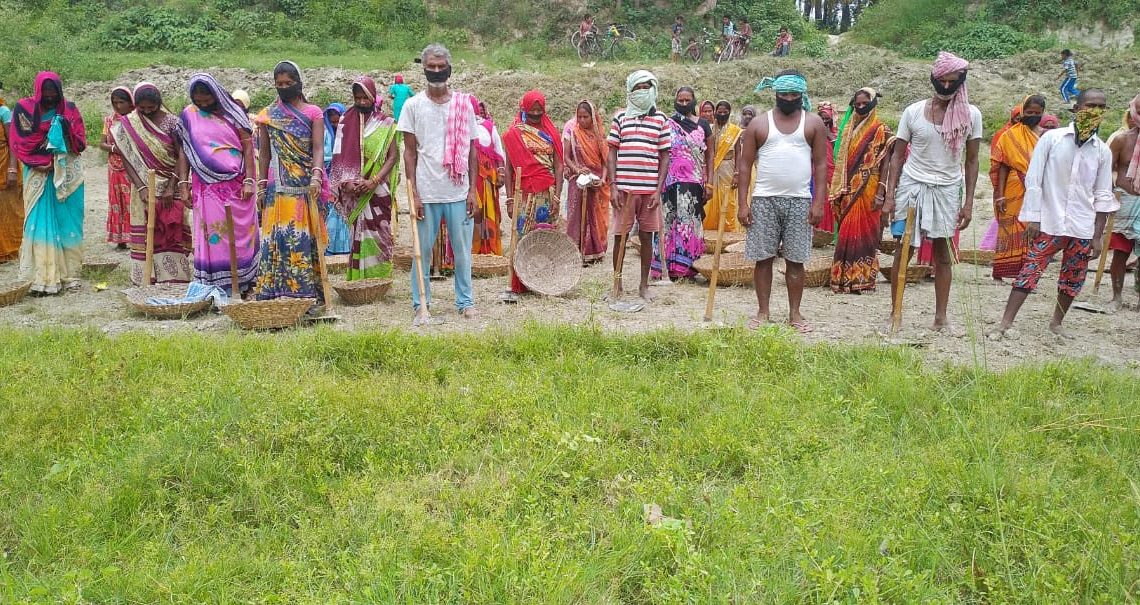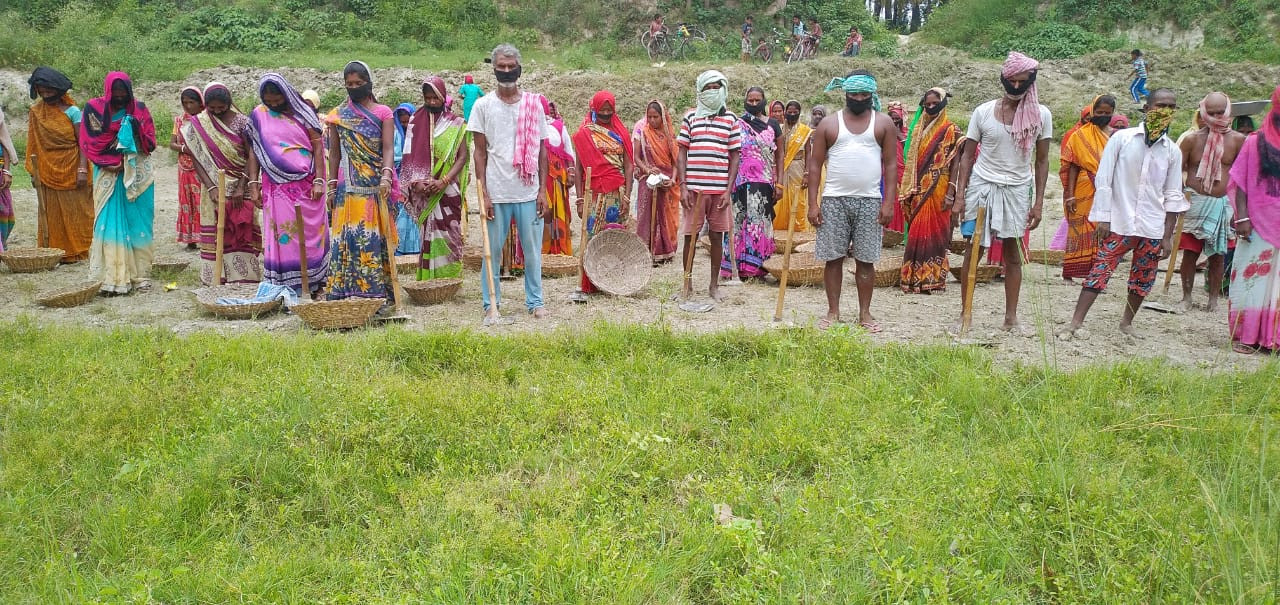
Indians are Protesting the Hunger Crisis and Migrant Deaths Triggered By the Coronavirus Lockdown
June 6, 2020When the restaurant where 30-year-old Santosh Kumar worked had to close because of the government-mandated coronavirus lockdown, he had no choice but to make his way back home to the eastern state of Jharkhand. The five-day journey back by bus, from his workplace in the city of Hyderabad, was excruciating.
“I survived on tea and biscuits. Sometimes, we would get some rice. Now I’m home, and there’s still no word, and soon, the grains in my home will also run out,” he told VICE.
Rajeev Rai, another migrant worker, travelled four days from Surat, in the eastern state of Gujarat, to reach Jharkhand after the lockdown. Rai talked about the discrimination he and other migrants faced during their journey. “We had packed almonds, chappatis and water, even a stove. But once we ran out, we tried to get things from shops on the way,” he said. “The shopkeepers would shoo us away, or throw items or money at us because they thought we might be the carriers of the virus.”
He added, “We heard of other migrants, who walked back to Jharkhand, being chased away by people if they tried to sleep in empty buildings at night. There was no facility by the government to fall back on.”
Stories like Kumar's and Rai’s exemplify the neglect and brutal treatment of migrants under one of the world’s strictest and harshest lockdowns. India's nationwide lockdown, announced on March 25, effectively demanded 1.8 billion people to stay at home. The order saw a sudden shutdown of the economy and sealing of the borders in as little as four hours, and brute force being used by the state police against anyone seen outside. Migrants like Kumar and Rai, who were forced out of jobs once businesses and workplaces shut down, were suddenly forced to go home – on gruelling journeys that were fatal for many.
Even today, after lockdowns have eased in many states across the country, reports of migrants dying of hunger and exhaustion continue to trickle in. The causes range from walking hundreds of miles, to poorly arranged special trains meant to transport migrants home, to neglected quarantine centres, to joblessness.
But now migrants have had enough.
“We want justice for our fellow migrants who died,” said Kumar. “And answers for those who survived but are still facing a bleak future.”
Kumar and Rai are a part of hundreds of protests that have erupted across India. On June 1, migrants in over 700 rural and urban towns and villages staged a peaceful protest to demand justice for the workforce that forms the backbone of the country's most thriving cities. They wore masks, maintained social distancing and carried placards with messages like “Why should my child stay hungry? We also voted for you,” and “Stop this cruelty on migrant labourers. We will remember this.”
In other parts of the country, protests turned violent. In Chennai, 500 stranded migrants staged a protest after they reportedly did not get anything to eat for three days, at the construction site they were employed at. In Gujarat, clashes included stone-pelting and violence against paramilitary forces. In Mumbai, migrants who ran out of rent money and food clashed with local police. Similar incidents erupted in other states.

“The plight of migrants and the hunger problem is not just one state’s problem right now. It is the same across the country,” said Ashrfinand Prasad, an activist in Ranchi, Jharkhand, who works with non-profit Right To Food Campaign, which is focused on food security.
Jharkhand is one of the worst-hit states in terms of poverty and hunger under the lockdown. It is also one of the many battlegrounds for the migrants staging their protests.
India already ranks poorly in the global hunger statistics, so the pre-existing problem of malnourishment has been made worse by the lockdown-induced mass starvation. A study found that 90 percent of workers lost livelihood under the lockdown, while 94 percent don’t have access to the central government’s compensations such as food relief. Some experts say that there’s actually no way of knowing how many died due to starvation, although conservative reports show it is at least a few hundred.
The crisis is now impacting other aspects of migrants’ lives too. “Apart from the hunger and deaths, the migrants are also traumatised. There is a huge mental health crisis in this section of society. Some migrants are committing suicide,” Prasad told VICE.
In May, the Indian Psychiatry Society observed that one in five Indians showed signs of mental distress under the lockdown. In rural pockets, this has been caused by reverse migration. Prasad added that hunger and suffering also led to increased cases of conflicts within homes.
Right to Food Campaign, which has been mobilising migrants for work in their native towns and also providing them with relief, notes that the situation is too alarming to ignore. “We’ve been doing relief work and petitioning since 2001, but this has been going on for too long. The government response has been inadequate,” said Dipa Sinha, the organisation’s convener. “We have started campaigns across the country wherein migrants feel safe and comfortable to raise their voices, and not remain passive agents in this scenario.”
As a part of this campaign, Right to Food has been posting protest visuals from the ground on Twitter as well as pushing the issue to policy officials and governments. “Even though the crisis is unprecedented, it doesn’t mean that the authorities stop being accountable,” she added.
The Indian government claims it has provided substantial relief distribution, but activists say the majority of migrants slip through the cracks of the social welfare system because they lack adequate identification papers or bank accounts. Rupesh, an activist in Patna, in the east Indian state of Bihar, warned of a looming debt crisis in one of the poorest regions in India.
“Here, the state government promised Rs 1,000 ($13 USD) to be deposited into people’s accounts. But we found that 60 percent of people didn’t get that because they don’t have bank accounts,” he said. “There’s also another problem. People are taking loans to cover for the loss of livelihoods during the lockdown. Very soon, this will blow up and we will have a debt crisis in the state.”
At the beginning of the lockdown, Finance Minister Nirmala Sitharaman announced a relief package for daily wage earners saying, “The government does not want anyone to remain hungry.” As of writing, government officials have yet to acknowledge the crisis, even going so far as to deny it is happening.
Despite the mass exodus of migrants after the lockdown in March, Solicitor General of the Supreme Court Tushar Mehta claimed, “No migrant person was walking on the roads in an attempt to reach his/ her home towns villages.” Last month, the highest judicial body also declined a petition to help stranded and hungry migrants, stating, “It is impossible for this court to monitor who is walking and who is not.”
As the situation worsened, more relief schemes were promised in the form of housing and food for migrants. Yet the crisis remains unchanged.
India is not alone. In Chile, food shortages caused by the pandemic and the lockdown led to social unrest and even violence. The same happened in Venezuela, while in Colombia, impoverished families hung red rags outside their homes as an SOS for the hunger crisis. But in India, there’s a unique problem. Here, the starvation is juxtaposed with an unsettling amount of excessive food that are lying in India’s government warehouses. A recent report found 6.5 million tonnes of excess grains, meant for the public, allowed to rot during the lockdown—an amount that is said to be more than what was distributed through the government food distribution scheme.
The Food Corporation of India denied allegations of food wastage.
Jayati Ghosh, a professor at the Centre for Economic Studies and Planning at the Jawaharlal Nehru University in New Delhi, emphasises that the government, not the virus, is to blame for the hunger crisis. “The first point to note in terms of this hunger crisis is that this is not related to the virus. It is 100 percent policy-driven when the complete and brutal lockdown was imposed without notice,” Ghosh told VICE.
“We have 95 percent informal workforce, 50 percent are self-employed, and 80 percent of the rest depend on daily wages. These are not new facts. The government knew this, and despite that, the lockdown was imposed and drove people to starvation.” Ghosh called the hunger crisis a “betrayal” under the pandemic. “The nature of this betrayal [of the migrants] is unprecedented in Indian history, and unmatched by any other country in the world,” she said.
But the worse may be far from over. Sitaram Rai, a 24-year-old migrant worker from Jharkhand, said that the current unemployment and hunger problems may just be the beginning.
“There’s definitely more to come over the next three to four months,” he said. “We will be jobless in our native villages. And our only other option is to return to the cities where we worked. Who knows if we will come back alive, whether due to the virus or not.”
Ghosh reiterated the concern. “We will realise the extent of this damage only once the lockdown lifts. Many activities will not exist, along with many jobs, and sources of livelihoods. It’s a terrifying prospect, and it’s clear that the government does not have a grip on this basic reality.”
Follow Pallavi Pundir on Twitter.
This article originally appeared on VICE IN.

